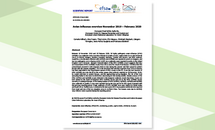#18,332
The ECDC publishes a highly detailed avian influenza surveillance report roughly every 3 months, and while they tend to be EU centric, in its 60+ pages you'll find ample coverage of outbreaks and infections from around the world.The graphic above illustrates that between 2016 and 2021 we saw a steep decline in human infections with HPAI H5N1 around the globe. Much of this was due to the dominance of an H5N8 subtype between 2014 and 2019.
Avian influenza hadn't gone away, of course, as not shown are > 1,500 H7N9 cases in China (2013-2018), and infections with a smattering of other subtypes (H5N6, H9N2, H7N2, H10Nx, etc.). It is also likely that due to limited surveillance and sharing of data, some cases were simply never detected and/or reported.
In 2021, following a complex series of genetic changes to the H5N1 virus, we began to see a global surge and spread of H5N1, characterized by increased spillovers into mammals (mink, foxes, marine mammals, and eventually even cattle).
Human cases has risen as well (see chart below), although again, these numbers may not represent the true burden of these infections.
There have been some encouraging trends, including a substantial drop in outbreaks in wild birds and poultry in Europe over the past year. Additionally, they report no new HPAI virus detections in mammals reported in Europe between 15 June and 23 September 2024.
Whether, and how long, these trends last remains to be seen, as we've seen quite a different situation unfolding in North America.
These quarterly reports make excellent reference material, well worth perusing. I've posted the ECDC summary and link below.
Surveillance and monitoring
3 Oct 2024Publication series: Avian influenza overview
Between 15 June and 20 September 2024, 75 highly pathogenic avian influenza (HPAI) A(H5) and A(H7) virus detections were reported in domestic (16) and wild (59) birds across 11 countries in Europe.
Although the overall number of detections in Europe continued to be low compared to previous epidemiological years, an increase in cases along the Atlantic, North Sea and Baltic coasts was notable, particularly an increase in the detection of HPAI viruses in colony-breeding seabirds. Besides EA-2022-BB and other circulating genotypes, these detections also included EA-2023-DT, a new genotype that may transmit more efficiently among gulls.
In Germany, HPAI A(H7N5) virus emerged in a poultry establishment near the border with the Netherlands. No new HPAI virus detections in mammals were reported in Europe during this period, but the number of reportedly affected dairy cattle establishments in the United States of America (USA) rose to > 230 in 14 states, and HPAI virus was identified in three new mammal species.
Between 21 June and 20 September 2024, 19 new human cases with avian influenza virus infection were reported from the USA (six A(H5N1) cases and five A(H5) cases), Cambodia (five A(H5N1) cases, including one fatal), China (one fatal A(H5N6) case and one A(H9N2) case), and Ghana (one A(H9N2) case). Most of the human cases (90%, n = 17/19) had reported exposure to poultry, live poultry markets, or dairy cattle prior to avian influenza virus detection or onset of illness.
Human infections with avian influenza viruses remain rare and no evidence of human-to-human transmission has been documented in the reporting period. The risk of infection with currently circulating avian A(H5) influenza viruses of clade 2.3.4.4b in Europe remains low for the general public in the European Union/European Economic Area (EU/EEA). The risk of infection remains low-to-moderate for those occupationally or otherwise exposed to infected animals or contaminated environments.
Avian influenza overview June–September 2024 - EN - [PDF-1.96 MB]


